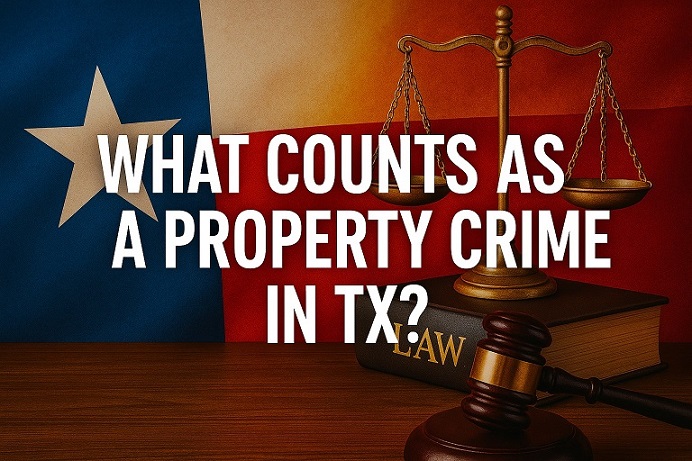When people hear the term “property crime,” their minds often jump straight to theft or vandalism. But in Texas, property crime laws cast a much wider net. These laws don’t just apply to stolen items they cover any criminal act that involves damage, interference, or unlawful access to another person’s property. That includes arson, graffiti, criminal mischief, trespassing, burglary, and even tampering with utilities. Each offense carries its own level of severity and potential punishment, ranging from minor fines to lengthy prison sentences.
Understanding the scope of property crime in Texas is essential for both residents and visitors. It’s not just about whether something was taken or damaged. Even entering private land without permission or spray-painting a wall can result in criminal charges. And because many of these offenses hinge on intent, people are sometimes charged based on actions that seem minor or harmless at the time.
In Texas, criminal property offenses are taken seriously. Property rights are deeply protected under state law, and courts often aim to hold offenders accountable for violating those rights. The consequences extend beyond legal penalties, too having a property crime conviction on your record can limit job prospects, block housing applications, and reduce eligibility for professional licenses.
This article breaks down what counts as a property crime in Texas, how these offenses are classified, and what kinds of penalties you could face. Whether you’re trying to clear up a misunderstanding, facing charges, or simply want to stay informed, understanding these laws is a smart first step.
Highlights
Legal Definition of Property Crime in Texas
 Under the Texas Penal Code, a property crime refers to any unlawful act that results in damage to, unauthorized access to, or interference with another person’s property. This broad legal category includes offenses like criminal mischief, theft, trespass, arson, and burglary. What ties these crimes together is the violation of someone’s right to control or use their own property whether it’s land, personal items, buildings, or vehicles.
Under the Texas Penal Code, a property crime refers to any unlawful act that results in damage to, unauthorized access to, or interference with another person’s property. This broad legal category includes offenses like criminal mischief, theft, trespass, arson, and burglary. What ties these crimes together is the violation of someone’s right to control or use their own property whether it’s land, personal items, buildings, or vehicles.
One of the key aspects in determining a property crime is intent. Texas law often focuses on whether the person meant to harm, steal, or tamper with the property. In many cases, recklessness or even accidental damage can still be criminal if it happens during the course of another unlawful act. For example, damaging someone’s fence while trespassing could still lead to criminal mischief charges even if the person didn’t mean to cause harm.
Texas law protects many types of property, including homes, businesses, vehicles, fences, signs, public utilities, and even data systems. Interfering with how someone uses or enjoys their property like disabling their lights, cutting off water, or tagging graffiti can lead to arrest. Importantly, you don’t always need to “steal” something for a crime to count as property-related.
Here’s a simplified breakdown of actions that qualify as property crimes in Texas:
-
Damaging or destroying property (e.g., breaking windows, spray-painting)
-
Taking someone else’s belongings without consent
-
Illegally entering a property, building, or vehicle
-
Setting fires to buildings or land
-
Tampering with electric, gas, or water systems
-
Obstructing, defacing, or altering property for personal use
Because of how broad this definition is, it’s easy to misunderstand where the legal line is drawn. Even a one-time mistake or poor judgment call can quickly escalate into a criminal charge. That’s why knowing the legal framework is so important—whether you’re trying to protect your rights or avoid unintentional violations.
Common Types of Property Crimes in TX
Texas recognizes a wide range of property crimes, many of which go beyond traditional ideas of theft or vandalism. While some offenses involve clear damage or stolen items, others are based entirely on unauthorized access, interference, or tampering, regardless of whether anything was taken or harmed. Understanding the different types of property crimes helps clarify what could lead to criminal charges even for actions that might seem harmless at first glance.
Here are some of the most common property crimes under Texas law:
-
Theft – Unlawfully taking someone else’s property with the intent to deprive them of it permanently. This includes shoplifting, stealing from a car, or taking items from someone’s yard.
-
Burglary – Entering a building or habitation without consent and with the intent to commit a felony, theft, or assault inside. Even entering a garage or car can qualify.
-
Criminal Mischief – Intentionally damaging or destroying property. This includes breaking windows, slashing tires, or damaging signage.
-
Arson – Starting a fire or causing an explosion with the intent to destroy property, whether it’s a building, vehicle, or open land.
-
Graffiti – Applying paint, markers, or etching tools to property without the owner’s consent. Often prosecuted alongside criminal mischief.
-
Trespass – Entering or remaining on someone’s land or property without permission. This includes ignoring “No Trespassing” signs or being on private land without consent.
-
Tampering with Utilities or Property – Interfering with meters, locks, fences, signs, or electrical lines. Even small acts, like cutting a chain or flipping a breaker, can lead to charges.
Each of these crimes has different consequences, and many can be either a misdemeanor or a felony depending on the value of the damage, the type of property affected, and whether the offender has a prior criminal history.
Real-life examples of common scenarios include:
-
Spray-painting initials on a public overpass (graffiti)
-
Entering an unlocked car to take spare change (burglary of a vehicle)
-
Tampering with a neighbor’s water valve after a dispute (criminal mischief)
-
Walking onto private ranch land without permission (trespassing)
Even if no theft occurred or damage was minimal, these actions still fall under Texas property crime statutes. That’s why it’s important to treat any accusation seriously what might seem like a small mistake can carry real legal weight.
Misdemeanor vs Felony Property Crimes in TX
The difference between a misdemeanor and a felony property crime in Texas can mean the difference between a small fine and years behind bars. The state uses a tiered system to classify property offenses, with punishments scaling based on the value of the property, intent, use of force or tools, and whether the property was residential, commercial, or public.
Misdemeanor Property Crimes
Most low-level offenses like minor vandalism, first-time trespass, or theft of inexpensive items are classified as misdemeanors. These cases are handled in county courts and carry lighter penalties. For example:
-
Class C Misdemeanor – Property valued under $100 or low-level graffiti
-
Penalty: Fine up to $500, no jail time
-
-
Class B Misdemeanor – Property worth $100–$750 or criminal trespass
-
Penalty: Up to 180 days in jail, up to $2,000 fine
-
-
Class A Misdemeanor – Property valued between $750–$2,500 or repeated trespass
-
Penalty: Up to 1 year in jail, up to $4,000 fine
-
Judges may also issue probation, community service, or restitution to help victims recover their losses, especially for first-time offenders.
Felony Property Crimes
More serious offenses become felonies, especially when the property damage is extensive or the crime involves a home, school, or government building. These are prosecuted in district courts and can lead to state jail or prison time:
| Felony Level | Common Offense Examples | Penalties |
|---|---|---|
| State Jail Felony | Property valued $2,500–$30,000, or burglary of a shed | 180 days to 2 years in state jail |
| Third-Degree Felony | Arson, property damage $30K–$150K, school vandalism | 2 to 10 years in prison |
| Second-Degree Felony | Arson with injury, burglary of home | 2 to 20 years in prison |
| First-Degree Felony | Arson causing death, large-scale property crimes | 5 to 99 years in prison |
Some crimes escalate automatically. For example, burglary of a habitation is always a second-degree felony, even if nothing was stolen. Likewise, repeat offenders or those who used tools or weapons during the crime face sentencing enhancements.
The line between misdemeanor and felony can be thin. If you steal a bike worth $100, that’s a Class B misdemeanor. But if it’s worth $2,600? You’re now facing felony charges even if it’s your first offense. Knowing how Texas draws these lines is crucial for understanding the risks and legal outcomes.
Penalties and Sentencing Guidelines in TX
Texas takes property crimes seriously, and penalties can be harsh even for first-time offenders. The punishment for a property crime depends on multiple factors: type of offense, value of the property, location, criminal intent, and prior history. The law provides a structured sentencing system that gives judges discretion, but in some cases, mandatory minimums apply, especially for felonies.
Sentencing Overview
Penalties can include a mix of the following:
-
Fines – From $500 for Class C misdemeanors to $10,000 for felonies
-
Jail or Prison Time – Ranges from no time at all to 99 years, depending on the charge
-
Probation – A supervised alternative to jail, often for first-time or non-violent offenses
-
Restitution – Court-ordered payment to victims for damage or losses
-
Community Service – May be part of probation terms or standalone sentencing
-
Deferred Adjudication – A form of probation that may result in dismissal if completed successfully
Here’s a sample table of sentencing ranges for different levels of offenses:
| Offense Level | Jail/Prison Time | Fine Limit |
|---|---|---|
| Class C Misdemeanor | None | Up to $500 |
| Class B Misdemeanor | Up to 180 days in jail | Up to $2,000 |
| Class A Misdemeanor | Up to 1 year in jail | Up to $4,000 |
| State Jail Felony | 180 days to 2 years | Up to $10,000 |
| Third-Degree Felony | 2 to 10 years | Up to $10,000 |
| Second-Degree Felony | 2 to 20 years | Up to $10,000 |
| First-Degree Felony | 5 to 99 years or life | Up to $10,000 |
Texas also applies sentence enhancements when certain aggravating factors are present. These include committing crimes in disaster zones, targeting elderly victims, or having multiple prior convictions. These enhancements can push a misdemeanor to a felony or increase the minimum required sentence.
Judges in Texas do have options for alternatives to incarceration, especially when dealing with younger defendants, property crimes without victims, or cases where the defendant shows genuine remorse and willingness to make restitution. However, once a case reaches the felony level, especially involving violence or high-value damage, the chance of avoiding jail time drops significantly.
Can You Be Charged Without Causing Damage?
Yes under Texas law, you can absolutely be charged with a property crime even if no physical damage occurred. The key element in many of these charges isn’t the damage it’s the unlawful action or intent. Many people mistakenly believe that if no property was broken or stolen, they’re safe from prosecution. But Texas statutes allow for criminal charges based on trespass, tampering, or attempted crimes, even when nothing is physically altered.
Take criminal trespass for example: if you enter a fenced yard or private building without permission—even without breaking anything you can be arrested. Intent and presence are enough. Similarly, tampering with property, like turning off someone’s power supply or jiggling a locked doorknob, could lead to charges even if no theft or entry occurred.
Attempted burglary is another area where damage isn’t required. If someone is caught trying to open a car or home window but is stopped before gaining entry, prosecutors can still pursue charges. In fact, attempted crimes often carry nearly the same penalties as completed ones, especially when tools are involved or a pattern of intent is established.
Let’s look at some real examples where damage wasn’t necessary for a criminal case:
-
A person is seen trying multiple car doors in a parking lot—charged with attempted burglary of a vehicle
-
An individual walks into an unlocked building at night—charged with criminal trespass
-
Someone disables a neighbor’s security camera without damaging it—charged with interference with property
This is why understanding intent-based charges is so important in Texas. The state doesn’t need proof of shattered glass or stolen goods to file charges. All it takes is unauthorized action or perceived threat to someone’s property rights, which makes these laws surprisingly broad and easy to violate unknowingly.
Why You Should Contact a Lawyer for a Property Crime in TX
Being accused of a property crime in Texas is not something to take lightly. Whether you’re facing a misdemeanor or a felony, even the smallest charge can leave a permanent mark on your criminal record, affect your job prospects, and limit your housing and licensing opportunities. That’s why contacting a criminal defense attorney as soon as possible is one of the most important steps you can take after being arrested or charged.
A skilled attorney can help you understand the charges, review the evidence, and determine if your rights were violated at any point during your arrest or investigation. In some cases, they may be able to negotiate reduced charges or a complete dismissal, especially if you are a first-time offender or if the case involves unclear intent or minor damage. Attorneys also know how to argue for alternatives to jail time like deferred adjudication, community supervision, or restitution agreements.
The earlier you involve a lawyer, the more options you have. Many defendants who try to handle their case alone unknowingly accept plea deals that leave them with avoidable convictions, larger fines, or harsher penalties. An attorney can challenge improper police procedures, question unreliable witnesses, and present evidence in your favor that may not otherwise come to light.
Beyond fighting the current charge, a lawyer also plays a key role in helping you protect your future. They can guide you through the expungement or non-disclosure process if you’re eligible to clear your record. Property crime cases may seem minor at first but the legal and financial consequences are often long-term. The right defense can make the difference between a clean slate and a permanent stain on your record.
FAQs About Property Crimes in Texas
What is the most common property crime in Texas?
Theft is the most commonly reported property crime in Texas. This includes a wide range of activities, such as shoplifting, stealing from parked cars, and unlawfully taking someone’s personal property. Most theft cases are classified based on the monetary value of the stolen items, and they can range from a minor Class C misdemeanor to a serious felony.
In urban areas, petty theft and vehicle-related break-ins top the list. In rural parts of the state, it’s more common to see property crimes related to trespassing, livestock theft, or tampering with equipment. Regardless of location, theft remains one of the most frequently prosecuted offenses across Texas counties.
Is breaking a window always considered criminal mischief?
Yes if you intentionally break someone else’s window in Texas, that act qualifies as criminal mischief under the Texas Penal Code. The law covers any intentional or knowing destruction or damage to tangible property. It doesn’t matter if the window is on a car, house, or business if it’s not your property and you damage it, it can lead to charges.
The severity of the charge depends on the cost to repair or replace the window. If it’s less than $100, it may be a Class C misdemeanor. But if the damage exceeds $2,500 or if the act is part of a broader criminal act like burglary it could become a felony. Even something as seemingly minor as kicking a window out of frustration can lead to arrest.
Can I be arrested for tampering with a vehicle in TX?
Absolutely. In Texas, tampering with a vehicle whether it’s trying to open a locked door, messing with the ignition, or removing a license plate without permission can result in criminal charges. Depending on the intent, it may be prosecuted as criminal mischief, attempted theft, or burglary of a vehicle.
Law enforcement doesn’t need to wait for you to drive away with the vehicle to make an arrest. If you’re caught trying to gain entry or interfere with any part of someone else’s vehicle, it can be enough to justify charges. Penalties range from fines and probation to jail time especially if the incident involves repeat offenses or tools commonly used for theft
How do I remove a property crime from my record?
In Texas, it may be possible to remove a property crime from your record through expunction or non-disclosure, but eligibility depends on the outcome of your case. If your case was dismissed, you were acquitted, or you successfully completed deferred adjudication, you may qualify to have the charge sealed or erased from public view.
The process can be complicated and varies by charge type, so it’s best to speak with a criminal defense attorney who handles record-clearing cases. Having a property crime sealed or expunged can significantly improve your ability to pass background checks for employment, housing, or licensing and it gives you a fresh start.



